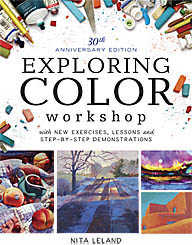The logic of color
Newton started it when he connected the ends of the prism to make the first color wheel. Some time later someone else noticed that certain colors, designated "primary colors," could be used to mix other colors in paint. Eventually, another individual discovered the nature of complements, opposites on the color wheel. Understanding these characteristics of color is key to good color in artwork. Some people have an intuitive sense for color, but if something isn't working, they find it hard to solve the problem without going to color theory. Granted, the rules we know about color are "theories," but they're based on principles that work in the real world. There have been hundreds of color theories based on three to six "primaries,"; there are color wheels, color solids, color triangles and color bars. One theory that has stood the test of time is the color wheel based on twelve hues. This wheel gives you the primaries, the secondaries (colors mixed from two primaries) and the tertiaries (colors mixed from a primary and the secondary next to it). If the mixtures don't give you the results you want, it isn't the theory that's at fault--it's the paint. Our pigments aren't pure, spectral colors like the colors of light. Their density and handling characteristics sometimes get in the way. If you want to become a master colorist, study the properties of color, learn the characteristics of your paints and use the logic of the color wheel.
Labels: color, color theory, color wheel, tutorials





7 Comments:
ohmygosh! You have a blog... how wonderful. I discovered your web site about six months ago and have thoroughly enjoyed it. And I particularly enjoyed the 'art studio tours' in photographs. I love seeing where others work their creations. Obviously, its been too long since I visited your site or I would have known you've been blogging since September. My bad. I'd just like to say "thanks for blogging".
And thanks for commenting. I hope you can find time to catch up on all the posts since September. I love blogging! So much to say, so little time, but blogging makes it easy.
It's easy to get a bit lost in color theory. One of the elements that has been key to opening my eyes about handling color has been color bias as a method of understanding color mixing. I considered it nothing short of a revelation when I found it. Color mixing that had seemed arbitrary and confusing became much more logical and predictable.
Sounds like a great idea for a blog--"color bias." I agree that this makes a huge difference in color mixing. It's the foundation of my split-primary color-mixing system.
Hello Nita,
Am thrilled that Crusty Crone mentioned your blog on her blog. I am a great admirer and have most of your books. Sooooo, you can be sure that I will absolutely be "attending" and enjoying everything you have to share.
First question of the day...what is color bias?? And Thank You for blogging. This is going to be such fun!!!!
thanks for stopping by, edeee. Guess I'll do that blog on color bias later today.
Keep on coloring, Nita. You're teachings are highly appreciated by me and many others.
Post a Comment
<< Home